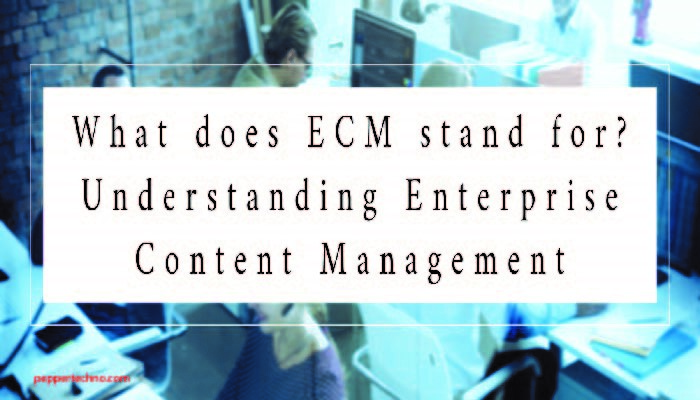What Does ECM Stand For: The Ultimate Guide
We are discussing what does ECM stand for. In today’s digital age, managing and organizing vast amounts of information has become a critical task for businesses of all sizes. This is where Enterprise Content Management (ECM) comes into play. ECM, which stands for Enterprise Content Management, is a set of strategies, tools, and technologies that enable organizations to capture, store, manage, and distribute their content in a secure and efficient manner.
The importance of ECM cannot be overstated. With the exponential growth of digital content, businesses need a robust system in place to effectively manage and utilize their information assets. ECM provides a centralized platform that allows organizations to streamline their content management processes, improve collaboration, ensure compliance with regulations, and enhance overall operational efficiency.

Introduction to ECM: Understanding the Basics
ECM can be defined as a comprehensive approach to managing an organization’s content throughout its lifecycle, from creation to disposal. It encompasses a wide range of activities, including document capture, storage, retrieval, version control, workflow management, and records management.
Key features and functionalities of ECM include document imaging and scanning, document indexing and metadata management, document storage and retrieval, document version control and audit trails, workflow automation, and records management. These features enable organizations to efficiently manage their content, improve productivity, reduce costs, and ensure compliance with regulatory requirements.
One key difference between ECM and traditional document management systems is the scope of content that they can handle. While document management systems primarily focus on managing electronic documents, ECM goes beyond that by also encompassing other types of content such as emails, web pages, multimedia files, and social media posts.
The Evolution of ECM: From Document Management to Enterprise Content Management
The concept of ECM can be traced back to the early days of document management systems in the 1980s. At that time, businesses were primarily concerned with managing paper-based documents and finding ways to digitize and store them electronically.
Over the years, ECM has evolved to meet the changing needs of businesses and advancements in technology. With the advent of the internet and the proliferation of digital content, organizations started to realize the need for a more comprehensive approach to managing their content.
The role of technology has been instrumental in the evolution of ECM. The development of advanced scanning and imaging technologies, as well as the emergence of cloud computing and mobile devices, has revolutionized the way organizations capture, store, and access their content. These technological advancements have made ECM more accessible, scalable, and cost-effective for businesses of all sizes.
Key Components of ECM: Document Capture, Workflow, and Storage
ECM consists of several key components that work together to create a comprehensive content management solution. These components include document capture, workflow management, and storage.
Document capture involves the process of converting physical documents into digital format. This can be done through scanning or imaging technologies. Once the documents are digitized, they can be indexed and stored in a centralized repository for easy retrieval.
Workflow management is another important component of ECM. It involves automating and streamlining business processes by defining rules and workflows for document routing, approval, and collaboration. Workflow management ensures that documents are routed to the right people at the right time, reducing manual errors and improving efficiency.
Storage is a critical component of ECM as it involves securely storing and managing content throughout its lifecycle. ECM provides a centralized repository where all content is stored, ensuring that it is easily accessible and protected from unauthorized access or loss.
Some popular ECM tools that organizations can consider for each component include Adobe Experience Manager for document capture, Microsoft SharePoint for workflow management, and OpenText Content Suite for storage.
Benefits of ECM: Improved Efficiency, Compliance, and Collaboration
ECM offers several benefits to organizations that implement it. One of the key benefits is improved efficiency. By automating manual processes and streamlining workflows, ECM enables organizations to reduce the time and effort required to manage their content. This leads to increased productivity and cost savings.
Compliance is another important aspect of ECM. With the increasing number of regulations and data privacy laws, organizations need to ensure that their content is managed in a compliant manner. ECM provides features such as version control, audit trails, and records management that help organizations meet regulatory requirements and mitigate legal risks.
ECM also enhances collaboration among team members. By providing a centralized platform for content management, ECM enables employees to easily access and share information, collaborate on documents, and track changes. This improves communication and teamwork, leading to better decision-making and faster time to market.
ECM vs. DMS: What’s the Difference?
While ECM and Document Management Systems (DMS) share some similarities, there are key differences between the two. DMS primarily focuses on managing electronic documents, whereas ECM encompasses a broader range of content types.
DMS is typically used for document storage, retrieval, and version control. It provides features such as document scanning, indexing, and search capabilities. ECM, on the other hand, goes beyond document management and includes features such as workflow automation, records management, and collaboration tools.
Both ECM and DMS have their advantages and disadvantages. DMS is often easier to implement and use, making it a good choice for small businesses with simple content management needs. However, it may lack the advanced features and scalability that larger organizations require.
ECM, on the other hand, offers a more comprehensive solution for managing content across the enterprise. It provides advanced features such as workflow automation and records management that can greatly improve efficiency and compliance. However, ECM can be more complex to implement and may require more resources and expertise.
The choice between ECM and DMS depends on the specific needs and requirements of the organization. Small businesses with limited content management needs may find DMS sufficient, while larger organizations with complex workflows and compliance requirements may benefit from implementing ECM.
ECM in Action: Real-World Use Cases and Success Stories
There are numerous examples of companies that have successfully implemented ECM and reaped the benefits. One such example is the pharmaceutical company Pfizer. Pfizer implemented an ECM solution to streamline its document management processes and improve collaboration among its global workforce. The ECM solution enabled Pfizer to automate document workflows, reduce manual errors, and ensure compliance with regulatory requirements.
Another example is the financial services company American Express. American Express implemented an ECM solution to digitize and centralize its customer documents, improving customer service and reducing costs. The ECM solution enabled American Express to easily retrieve customer documents, automate document routing, and provide a seamless customer experience.
These success stories highlight the potential of ECM to transform business operations and achieve strategic goals. By implementing ECM, organizations can improve efficiency, ensure compliance, enhance collaboration, and gain a competitive edge in today’s digital landscape.
Choosing the Right ECM Solution: Factors to Consider
Choosing the right ECM solution is a critical decision that can have a significant impact on the success of an organization’s content management initiatives. There are several factors that organizations should consider when evaluating different ECM vendors.
One key factor to consider is the scalability of the ECM solution. Organizations should choose a solution that can grow with their business and accommodate future needs. This includes considering factors such as the number of users, storage capacity, and the ability to integrate with other systems.
Another important factor is the ease of use and user experience of the ECM solution. Organizations should choose a solution that is intuitive and user-friendly, as this will increase user adoption and minimize training requirements.
Integration capabilities are also important when selecting an ECM solution. Organizations should choose a solution that can seamlessly integrate with their existing systems, such as ERP or CRM systems, to ensure a smooth workflow and avoid data silos.
Other factors to consider include the security and compliance features of the ECM solution, the level of customer support provided by the vendor, and the total cost of ownership.
Implementing ECM: Best Practices and Common Challenges
Implementing ECM can be a complex process that requires careful planning and execution. To ensure a successful implementation, organizations should follow best practices and be aware of common challenges.
One best practice is to start with a clear understanding of the organization’s content management needs and goals. This includes identifying the types of content that need to be managed, the workflows that need to be automated, and the compliance requirements that need to be met.
Another best practice is to involve key stakeholders from different departments in the planning and implementation process. This ensures that the ECM solution meets the needs of all users and departments and increases user adoption.
Change management is another critical aspect of ECM implementation. Organizations should communicate the benefits of ECM to employees, provide training and support, and address any concerns or resistance to change.
Common challenges that organizations face when implementing ECM include data migration, system integration, and user adoption. Data migration involves transferring existing content from legacy systems to the new ECM solution. System integration involves integrating the ECM solution with other systems such as ERP or CRM systems. User adoption involves getting employees to use the new ECM solution and change their workflows and habits.
To overcome these challenges, organizations should carefully plan and execute data migration, work closely with vendors to ensure seamless system integration, and provide training and support to employees to increase user adoption.
ECM Trends to Watch: Cloud-Based Solutions and AI Integration
The ECM landscape is constantly evolving, with new trends and technologies emerging. Two key trends to watch are the rise of cloud-based ECM solutions and the integration of Artificial Intelligence (AI) into ECM.
Cloud-based ECM solutions offer several advantages over traditional on-premises solutions. They provide scalability, flexibility, and cost savings, as organizations can pay for only the resources they need. Cloud-based ECM solutions also offer improved accessibility, as users can access their content from anywhere, at any time, using any device.
AI integration is another trend that is transforming the ECM landscape. AI technologies such as Natural Language Processing (NLP) and Machine Learning (ML) can be used to automate content classification, metadata extraction, and document routing. This can greatly improve efficiency and accuracy in content management processes.
The potential impact of these trends on the ECM landscape is significant. Cloud-based solutions are expected to become the norm, as organizations increasingly adopt cloud technologies for their content management needs. AI integration is also expected to become more prevalent, as organizations look for ways to automate manual processes and improve decision-making.
Conclusion: The Future of ECM and Its Role in Digital Transformation
ECM will continue to play a crucial role in digital transformation by enabling organizations to effectively manage their content assets and gain a competitive edge in today’s digital landscape. As technology continues to advance, ECM will evolve to meet the changing needs of businesses and provide innovative solutions for content management.



